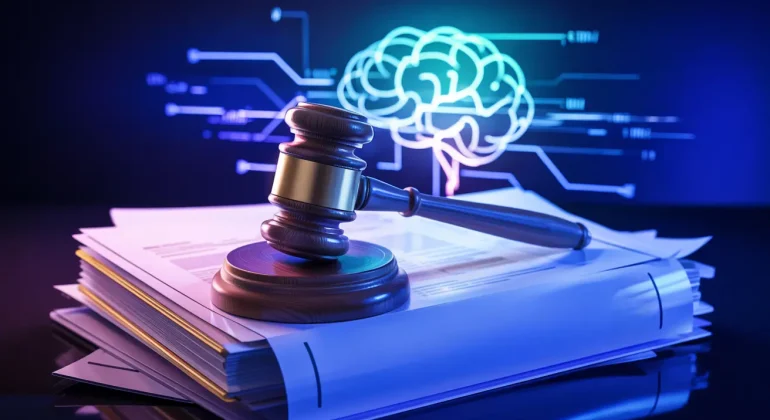Thomson Reuters Enterprise Centre GmbH et al v. ROSS Intelligence Inc., Docket No. 1:20-cv-00613
In the rapidly evolving landscape of artificial intelligence (AI), the intersection of AI development and intellectual property rights has become a focal point of legal discourse. The case of Thomson Reuters Enterprise Centre GmbH and West Publishing Corp. v. Ross Intelligence Inc. dated February 11, 2025 serves as a landmark in this context, addressing critical questions about the use of copyrighted materials in AI training processes.
Sommaire [masquer]
Background of the case
Parties involved
Thomson Reuters Enterprise Centre GmbH and its subsidiary, West Publishing Corp., are prominent providers of legal research and information services, notably through their Westlaw platform. Ross Intelligence Inc., on the other hand, was an AI startup aiming to revolutionize legal research by developing an AI-powered platform to provide efficient legal information retrieval.
Nature of the dispute
The dispute arose when Thomson Reuters alleged that Ross Intelligence had unlawfully utilized content from Westlaw’s proprietary database to train its AI system. Specifically, Thomson Reuters contended that Ross had copied headnotes and other editorial enhancements from Westlaw without authorization, constituting copyright infringement. Ross Intelligence countered by asserting that their use of the materials fell under the fair use doctrine, a legal principle permitting limited use of copyrighted works without permission under certain circumstances.
Legal issues presented
Copyright infringement allegations
Thomson Reuters claimed that Ross Intelligence’s actions amounted to direct and willful copyright infringement. The crux of their argument was that the headnotes and editorial content in Westlaw are original works protected under copyright law, and Ross’s reproduction of these elements for commercial gain violated their exclusive rights.
Fair use defense
In response, Ross Intelligence invoked the fair use defense, arguing that their use of Westlaw’s content was transformative and served the public interest by fostering innovation in legal research. They posited that their AI system did not merely replicate the original content but utilized it to develop a novel tool that enhanced legal information accessibility.
Court’s analysis and decision
Evaluation of copyright claims
The court meticulously examined whether the materials in question were subject to copyright protection. It affirmed that the headnotes and editorial content produced by Thomson Reuters involved sufficient creativity and originality to warrant copyright protection, thereby recognizing them as protected works under the law.
Assessment of fair use doctrine
The court then evaluated the applicability of the fair use doctrine by analyzing the following factors:
- Purpose and character of the use: The court determined that Ross’s use was commercial and not sufficiently transformative, as it replicated the original content’s purpose.
- Nature of the popyrighted work: The works used were factual but included creative elements, weighing against fair use.
- Amount and substantiality of the portion used: Ross had used a substantial portion of the protected content, which was central to Thomson Reuters’ offerings.
- Effect on the market: The court found that Ross’s use could potentially supplant the market for Westlaw’s services, adversely affecting Thomson Reuters’ revenue.
Based on this analysis, the court concluded that Ross Intelligence’s use did not qualify as fair use and constituted copyright infringement.
Broader implications for AI and copyright
Impact on AI training practices
This ruling underscores the necessity for AI developers to exercise caution when using copyrighted materials for training purposes. It highlights that unauthorized use of protected content, even for innovative applications, may lead to legal repercussions. Developers are encouraged to seek licenses or utilize public domain data to mitigate infringement risks.
Future legal considerations
The case sets a precedent for how courts may approach similar disputes involving AI and copyrighted content. It emphasizes the importance of balancing technological advancement with the protection of intellectual property rights. Stakeholders in the AI industry should closely monitor legal developments and consider proactive measures, such as developing internal guidelines for content use and engaging in policy discussions to shape future regulations.
Conclusion
The Thomson Reuters v. Ross Intelligence case serves as a pivotal reference point in the ongoing dialogue between AI innovation and copyright law. It illustrates the complexities inherent in applying traditional intellectual property principles to modern technological contexts and signals a call to action for both legal professionals and AI developers to navigate these challenges collaboratively.
Need expert guidance on AI and intellectual property? Dreyfus Law Firm specializes in intellectual property law, including trademark, copyright, and AI-related legal matters. Our experts stay ahead of AI and copyright developments!
Dreyfus Law Firm collaborates with a global network of IP attorneys.
Join us on social media !
FAQ
- What was the main issue in the Thomson Reuters v. Ross Intelligence case?
The primary issue was whether Ross Intelligence’s use of Thomson Reuters’ copyrighted materials to train its AI system constituted fair use or copyright infringement.
- What is the fair use doctrine?
Fair use is a legal principle that allows limited use of copyrighted material without permission for purposes such as criticism, comment, news reporting, teaching, scholarship, or research.
- How did the court rule on the fair use defense in this case?
The court ruled against Ross Intelligence, determining that their use of the copyrighted materials did not meet the criteria for fair use and thus constituted infringement.
- What are the implications of this ruling for AI developers?
AI developers must be cautious when using copyrighted content for training purposes and should consider obtaining licenses or using public domain data to avoid legal issues.
- Does this case affect all AI applications using copyrighted materials?
While this case sets a significant precedent, each situation may differ based on specific facts. It’s advisable for AI developers to consult legal experts when dealing with copyrighted materials.
- Can AI systems use any copyrighted material under fair use?
Not necessarily. The applicability of fair use depends on factors such

